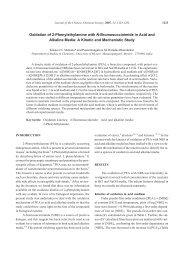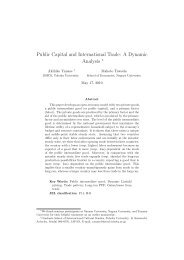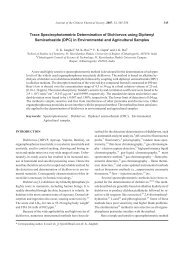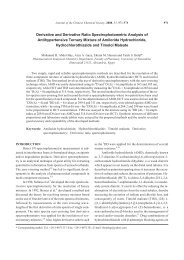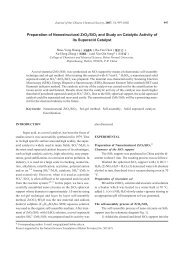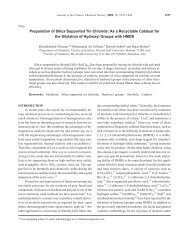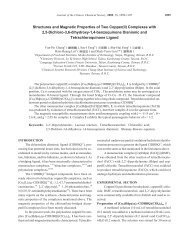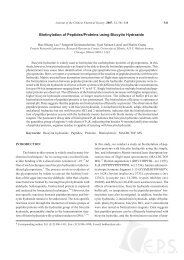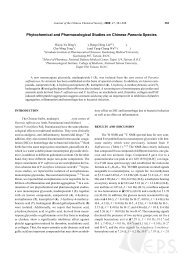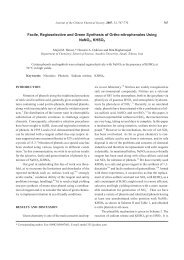Photoinduced Aromatization of Unsymmetrically Substituted 1,4 ...
Photoinduced Aromatization of Unsymmetrically Substituted 1,4 ...
Photoinduced Aromatization of Unsymmetrically Substituted 1,4 ...
You also want an ePaper? Increase the reach of your titles
YUMPU automatically turns print PDFs into web optimized ePapers that Google loves.
<strong>Photoinduced</strong> <strong>Aromatization</strong> <strong>of</strong> <strong>Unsymmetrically</strong> <strong>Substituted</strong><br />
1,4-Dihydropyridines<br />
Hamid R. Memarian, a * Masumeh Abdoli-Senejani a and Dietrich Döpp b<br />
a University <strong>of</strong> Isfahan, Faculty <strong>of</strong> Science, Department <strong>of</strong> Chemistry, 81746-73441 Isfahan, Iran<br />
b Universität Duisburg-Essen, Organische Chemie, D-47057 Duisburg, Germany<br />
Irradiation <strong>of</strong> unsymmetrically substituted 1,4-dihydropyridines (1b-1j) while bubbling oxygen or argon<br />
through the solution resulted in aromatization to the corresponding pyridine derivatives (3b-3j).<br />
Compound 1a with 2-nitrophenyl substituent in 4-position undergoes elimination <strong>of</strong> water upon irradiation<br />
under both oxygen and argon atmospheres and formation <strong>of</strong> 3a with 2-nitrosophenyl substituent. On<br />
the other hand, irradiation <strong>of</strong> the compounds 1e, 1k and 1l with 4-hydroxy-3-methoxyphenyl, 5-methyl-<br />
2-furyl and 2-furyl substituent in this position, respectively, resulted in the expulsion <strong>of</strong> these substituents<br />
and formation <strong>of</strong> a pyridine derivative unsubstituted in position 4, namely compound 2. Chlor<strong>of</strong>orm as a<br />
solvent causes the photo-oxidation <strong>of</strong> these compounds by an electron transfer mechanism which is supported<br />
by the formation <strong>of</strong> dichloromethaneaccording to GC analysis and presence <strong>of</strong> acid (HCl) in the solution<br />
after irradiation.<br />
Keywords: <strong>Aromatization</strong>; 1,4-Dihydropyridines; Photochemistry; Photo-oxidation; Unsymmetrical<br />
substitution.<br />
INTRODUCTION<br />
1,4-Dihydropyridines are interesting compounds, especially<br />
because <strong>of</strong> their pharmaceutical activity. They also<br />
play an important role in synthetic, therapeutic and bioorganic<br />
chemistry. 1-4 The most interesting aspect <strong>of</strong> dihydropyridines<br />
can be attributed to the coenzyme reduced<br />
nicotinamide adenine dinucleotide (NADH). Due to their<br />
light sensitivity, many studies have been devoted to the<br />
photochemistry and photo-oxidation <strong>of</strong> symmetrical dihydropyridine<br />
drugs such as lacidipine, 5 nifedipine 6-10 and<br />
unsymmetrical dihydropyridine drugs such as amlodipine,<br />
11 nisoldipine, 12 nilvadipine 13 and nimodipine. 14 The<br />
purpose <strong>of</strong> these studies was to elucidate the effects <strong>of</strong> concentration,<br />
light intensity and pH on the photostability <strong>of</strong><br />
the title compounds. A number <strong>of</strong> studies have also been<br />
devoted to the mechanism <strong>of</strong> photo-degradation and photooxidation<br />
<strong>of</strong> these compounds and, especially, the role <strong>of</strong> a<br />
4-substituent in the rate <strong>of</strong> reaction. 15-20 The importance <strong>of</strong><br />
the oxidative reaction <strong>of</strong> these compounds is due to their<br />
similarity to the oxidative metabolism <strong>of</strong> these compounds<br />
with pharmaceutical activity in the liver to form pyridine<br />
derivatives, which become biologically inactive. 21,22 Hence,<br />
* Corresponding author. E-mail: memarian@sci.ui.ac.ir<br />
Journal <strong>of</strong> the Chinese Chemical Society, 2007, 54, 131-139 131<br />
a convenient method for the conversion <strong>of</strong> 1,4-dihydropyridines<br />
to pyridine derivatives is important for the investigation<br />
<strong>of</strong> their metabolism.<br />
In the course <strong>of</strong> our study on the chemistry <strong>of</strong> 1,4-dihydropyridines<br />
and especially photo-oxidation or photodehydrogenation<br />
<strong>of</strong> these compounds, we synthesized various<br />
1,4-dihydropyridine-3,5-diesters known as Hantzsch<br />
esters, 23 and 3,5-diacetyl-1,4-dihydropyridines and investigated<br />
their photochemical behavior by exposing them to<br />
UV-light in solution 24-27 or in the solid state. 28 We have also<br />
investigated photosensitized oxidation <strong>of</strong> these compounds<br />
using triplet dye-sensitizers for in situ generation <strong>of</strong> singlet<br />
oxygen as oxidant. 29 The aim <strong>of</strong> these works was to investigate<br />
the effect <strong>of</strong> the presence <strong>of</strong> the acetyl groups instead<br />
<strong>of</strong> the carboethoxy groups (ester groups), the nature <strong>of</strong> 4substituent<br />
on the dihydropyridine ring and also the presence<br />
or absence <strong>of</strong> oxygen atmosphere on the rate <strong>of</strong> oxidation.<br />
In continuation <strong>of</strong> our studies we were interested in<br />
synthesizing various unsymmetrically substituted 1,4-dihydopyridines<br />
in which a carboethoxy group (ester) and an<br />
acetyl group (keto) are located in 3- and 5-positions, respectively.<br />
30 Now we wish to report on the photochemical<br />
behavior <strong>of</strong> keto-ester dihydropyridines under oxygen and
132 J. Chin. Chem. Soc., Vol. 54, No. 1, 2007 Memarian et al.<br />
argon atmosphere.<br />
RESULTS AND DISCUSSION<br />
Irradiation (280 nm) <strong>of</strong> 15.10 -3 M solution <strong>of</strong> each<br />
<strong>of</strong> 1a-1l in chlor<strong>of</strong>orm by bubbling oxygen or argon through<br />
the solution was followed by thin layer chromatography<br />
(TLC) until the total disappearance <strong>of</strong> 1a-1l. The results are<br />
summarized in Table 1.<br />
Since the aim <strong>of</strong> this study was (i). the investigation<br />
<strong>of</strong> photochemical behavior <strong>of</strong> these compounds, dependent<br />
on the type and nature <strong>of</strong> 4-substituent and (ii). to elucidate<br />
the effect <strong>of</strong> oxygen atmosphere on the rate <strong>of</strong> reactions, we<br />
have carried out simultaneously the photoreactions under<br />
both oxygen and argon atmospheres. Because <strong>of</strong> the similarity<br />
<strong>of</strong> the products obtained on irradiation under both atmospheres,<br />
the products obtained under an argon atmosphere<br />
have not been isolated, except for 1e, and the times<br />
<strong>of</strong> total oxidation are determined by TLC monitoring. For<br />
this purpose, we have taken the same volumes with equal<br />
concentration <strong>of</strong> each <strong>of</strong> the compounds in two different<br />
test tubes and irradiated them simultaneously and continuously<br />
by purging with a stream <strong>of</strong> either oxygen or argon<br />
until total disappearance <strong>of</strong> 1,4-dihydropyridines is observed<br />
by following the reaction by TLC.<br />
The observed fast reaction under oxygen atmosphere<br />
is an indication <strong>of</strong> the involvement <strong>of</strong> the excited singlet<br />
state <strong>of</strong> 1b, 1e, 1i, 1j, 1k and 1l in the reaction, since the excited<br />
singlet state could not be quenched by triplet oxygen.<br />
In the cases <strong>of</strong> 1a, 1c, 1d, 1f, 1g and 1h the excited triplet<br />
state should be involved in the reaction, since a faster pho-<br />
Scheme I<br />
Table 1. Irradiation <strong>of</strong> dihydropyridines 1a-1l under O2 and Ar<br />
O2 Ar<br />
Product (%) I<br />
Time (h) II<br />
Product (%) III<br />
Time (h) II<br />
1a 3a (60) 0.66 3a 0.33<br />
1b 3b (71) 5.5 3b 36<br />
1c 3c (72) 9 3c 3.75<br />
1d 3d (40) 6 3d 5.5<br />
1e 2 (20)<br />
3e (50)<br />
9 2 (18)<br />
3e (49)<br />
22<br />
1f 3f (84) 12.5 3f 8<br />
1g 3g (73) 5.5 3g 3<br />
1h 3h (67) 6 3h 4<br />
1i 3i (65) 7.5 3i 8.5<br />
1j 3j (80) 6 3j 15<br />
1k 2 (63) 1.5 2 5<br />
1l 2 (74) 2.25 2 5<br />
I II<br />
Isolated yield. Irradiation times refer to disappearance <strong>of</strong> the<br />
starting material. III The products have not been isolated except<br />
for 1e and identified only by TLC.<br />
to-oxidation has been observed by bubbling argon through<br />
the solution under irradiation.<br />
We have also investigated the effect <strong>of</strong> the nature <strong>of</strong><br />
solvent on the rate <strong>of</strong> reaction. Whereas irradiation <strong>of</strong> only<br />
compound 1a in ethanol solution after 15 minutes led to the<br />
formation <strong>of</strong> compound 3a in 70% yield, other compounds<br />
were obtained unchanged even after 5-13 hours <strong>of</strong> irradiation<br />
in the same solvent. Therefore, we found that chlor<strong>of</strong>orm<br />
is a suitable solvent for our reaction. Owing to the formation<br />
<strong>of</strong> dichloromethane during the reaction, which has<br />
been proved by GC-analysis <strong>of</strong> the reaction mixture and by<br />
testing for acidity <strong>of</strong> the solution after irradiation (due to<br />
formation <strong>of</strong> HCl), we will propose an electron transfer
<strong>Photoinduced</strong> <strong>Aromatization</strong> <strong>of</strong> 1,4-Dihydropyridines J. Chin. Chem. Soc., Vol. 54, No. 1, 2007 133<br />
mechanism for this conversion, in which chlor<strong>of</strong>orm is involved<br />
in the reaction (Scheme II). According to the proposed<br />
mechanism, excited 1,4-dihydropyridine (PyH2*),<br />
especially 1b-1l, donates an electron to chlor<strong>of</strong>orm under<br />
formation <strong>of</strong> PyH2· + and CHCl3· . Elimination <strong>of</strong> HCl from<br />
both intermediates leads to the formation <strong>of</strong> a radical pair,<br />
namely hydropyridyl (PyH·) and dichloromethyl (·CHCl2)<br />
radicals. Hydrogen abstraction by ·CHCl2 radical completes<br />
the reaction by formation <strong>of</strong> the pyridine compound (Py)<br />
and dichloromethane. Other studies also have proposed<br />
this mechanism for the photo-oxidation <strong>of</strong> symmetrical<br />
1,4-dihydropyridines in CCl4 15 and CBrCl3 solutions. 17,20<br />
The interesting point in our study is the expulsion <strong>of</strong><br />
the 4-substituent in the cases <strong>of</strong> 1e, 1k and 1l with a 4-hydroxy-3-methoxyphenyl,<br />
5-methyl-2-furyl and 2-furyl<br />
substituent, respectively, in the 4-position-. The loss <strong>of</strong> the<br />
C-4 substituent upon irradiation <strong>of</strong> Hantzsch esters has<br />
been reported earlier only in the case <strong>of</strong> carboxy groups, 31<br />
some heterocyclic groups, 25 and secondary alkyl and benzyl<br />
groups. 25 The expulsion <strong>of</strong> the 4-substituent has also<br />
been reported upon irradiation <strong>of</strong> diketo-dihydropyridines<br />
with 5-methyl-2-furyl and 2-furyl substituents in the 4 position.<br />
26 Thermal oxidation <strong>of</strong> Hantzsch esters with expulsion<br />
<strong>of</strong> benzylic and secondary alkyl substituents by various<br />
oxidants has also been cited. 26 Most <strong>of</strong> the product derived<br />
from 1d in our work is converted to an unidentified<br />
compound, which stays on the start line when separation is<br />
attempted by PLC and which we considered to be the pyridinium<br />
salt. However, shaking <strong>of</strong> this zone with NaOHsolution<br />
and extraction <strong>of</strong> the aqueous phase with CHCl3<br />
did not give any isolable product.<br />
IR (Table 2), 1 H NMR (Table 3) and UV data (Table<br />
4) gave useful information on the structural assignment <strong>of</strong><br />
Scheme II<br />
Table 2. Comparison <strong>of</strong> the IR spectra I (/cm -1 ) 1a-1l with<br />
those <strong>of</strong> 3a-3j<br />
1 NH CO2C2H5 COCH3 3 CO2C2H5 COCH3 a 3333 1675 1655 a II<br />
1723 1705<br />
b 3289 1700 1645 b 1724 1710<br />
c 3333 1675 1662 c 1724 1688<br />
d 3264 1675 1643 d 1740 1726<br />
e 3291 1677 1640 e 1724 1702<br />
f 3300 1663 1640 f 1724 1700<br />
g 3341 1700 1654 g 1724 1697<br />
h 3290 1692 1648 h 1724 1694<br />
i 3033 1691 1662 i 1724 1705<br />
j 3162 1643 1632 j 1737 1722<br />
k 3307 1691 1646 2 1724 1691<br />
l 3231 1676 1660 2 1724 1691<br />
I<br />
The spectra have been taken as KBr disc, except for 3d which<br />
has been taken in CHCl3-solution. II The absorption at 1551 cm -1<br />
indicated the presence <strong>of</strong> a NO-group.<br />
the photoproducts 2 and 3a-3j.<br />
A comparison <strong>of</strong> the IR spectra showed the disappearance<br />
<strong>of</strong> the NH band and also the shift <strong>of</strong> both CO vibrations<br />
to higher frequency due to the aromatization <strong>of</strong> the<br />
ring, which changes the role <strong>of</strong> the ring from enamine-like<br />
in 1 to acceptor-like in 3. Comparison <strong>of</strong> the 1 H NMR spectra<br />
indicated the loss <strong>of</strong> the signals for NH and also for the<br />
substituent in position 4 because <strong>of</strong> the expulsion <strong>of</strong> this<br />
substituent upon photo-oxidation <strong>of</strong> 1e, 1k and 1l with formation<br />
<strong>of</strong> the identical product 2. In this case, 4-H appears<br />
in the aromatic region at 8.53 ppm. In the 1 H NMR spectra<br />
<strong>of</strong> photoproducts containing the 4-substituent, the loss <strong>of</strong><br />
NH and 4-H resonances was observed. Owing to aromatization<br />
<strong>of</strong> the ring and diminished conjugation <strong>of</strong> the C-C<br />
double bonds with both CO groups, the methyl protons in
134 J. Chin. Chem. Soc., Vol. 54, No. 1, 2007 Memarian et al.<br />
Table 3. Structurally relevant 1 H NMR chemical shifts ( values) <strong>of</strong> 1a-1j in comparison with 3a-3j<br />
1 4-H N-H 2-CH3 6-CH3 3-CH2CH3 3-CH2CH3 5-COCH3 3 4-H 2-CH3 6-CH3 3-CH2CH3 3-CH2CH3 5-COCH3 a 5.88 5.79 2.32 2.36 1.26 4.04, 4.24 2.37 a - 2.63 2.04 0.81<br />
2.70<br />
b 5.20 5.99 2.24 2.38 1.33 4.21 2.43 b - 2.59 2.07 1.05 4.11 2.67<br />
c 5.02 5.71 2.21 2.33 1.35 4.24 2.42 c - 2.54 1.95 1.04 4.11 2.62<br />
d 5.35 6.07 2.26 2.34 1.39 4.28 2.42 d - 2.52 2.03 1.09 4.16 2.60<br />
e 4.99 5.70 2.20 2.32 1.35 4.22 2.41 e - 2.55 1.97 1.05 4.12 2.63<br />
f 5.05 5.87 2.20 2.32 1.33 4.21 2.40 f - 2.54 1.92 0.92 4.04 2.64<br />
g 5.03 5.84 2.20 2.33 1.33 4.20 2.40 g - 2.55 1.99 1.02 4.09 2.64<br />
h 5.02 5.87 2.20 2.31 1.34 4.22 2.40 h - 2.55 1.94 0.99 4.08 2.63<br />
i 5.08 6.69 2.23 2.35 1.31 4.19 2.39 i - 2.58 2.04 1.09 4.09 2.67<br />
j 5.11 6.06 2.22 2.36 1.33 4.21 2.42 j - 2.58 2.05 0.98 4.07 2.67<br />
k 5.14 5.86 2.24 2.36 1.34 4.22, 4.29 2.37 2 8.53 2.80 2.65 1.45 4.44 2.88<br />
l 5.20 6.08 2.34 2.36 1.33 4.24 2.36 2 8.53 2.80 2.65 1.45 4.44 2.88<br />
1 Appears as two quartets.<br />
Table 4. Comparison <strong>of</strong> the UV-absorption [max (nm)] <strong>of</strong> the starting materials 1a-1j with<br />
those <strong>of</strong> photoproducts 3a-3j in methanol solution<br />
1 max (log ) 3 max (log )<br />
a 250 (4.22), 366 (3.72) a 219 (sh, 4.39), 279 (4.10), 310 (3.90)<br />
b 245 (4.04), 369 (3.49) b 211 (4.27), 259 (sh, 3.91)<br />
c 230 (4.26), 369 (3.88) c 223 (sh, 4.32), 275 (3.98)<br />
d 238 (4.15), 363 (3.80) d 224 (4.32), 281 (4.14)<br />
e 231 (4.18), 370 (3.88) e 223 (4.20), 276 (3.83), 296 (3.79)<br />
f 247 (3.91), 370 (3.63) f 222 (4.54), 269 (sh, 4.05)<br />
g 245 (4.20), 369 (3.82) g 225 (4.43), 269 (sh, 4.14), 307 (sh, 3.44)<br />
h 249 (4.16), 371 (3.94) h 213 (sh, 4.52), 264 (4.26)<br />
i 243 (4.39), 370 (3.95) i 209 (3.97), 266 (3.75)<br />
j 242 (4.65), 370 (4.21) j 212 (4.20), 268 (3.67)<br />
k 239 (4.06), 362 (3.80) 2 218 (4.20), 242 (4.05), 275 (3.77)<br />
l 244 (4.34), 361 (4.09) 2 218 (4.20), 242 (4.05), 275 (3.77)<br />
2- and 6-positions are shifted to opposite directions. The<br />
anisotropy effect 32 <strong>of</strong> the carbonyl group <strong>of</strong> the COCH3<br />
moiety in a planar pyridine ring causes a shift <strong>of</strong> the 6-CH3<br />
resonance to upper field. Since the resonance <strong>of</strong> the oxygen<br />
atom <strong>of</strong> the ethoxy group with CO moiety <strong>of</strong> the carboethoxy<br />
group, the anisotropy effect <strong>of</strong> the carbonyl moiety is<br />
not efficient, and 2-CH3 is shifted downfield. Such phenomena<br />
have been observed in the 1 H NMR <strong>of</strong> the dihydropyridine-diesters<br />
25 and diketo-dihydropyridines. 26 Conjugation<br />
<strong>of</strong> the acetyl carbonyl with the acceptor pyridine<br />
causes a downfield shift <strong>of</strong> the resonance <strong>of</strong> the acetyl<br />
group. Whereas the 1 H NMR spectra <strong>of</strong> 1g showed a multiplet<br />
centered at 7.24 for the p-chlorophenyl ring, due to<br />
conversion to the pyridine ring in 3g, the electron withdrawing<br />
character <strong>of</strong> the pyridine ring causes a downfield<br />
shift <strong>of</strong> the aromatic protons to 7.23 ppm (3- and 5-H) and<br />
7.43 ppm (2- and 6-H), which appear as a doublet <strong>of</strong> dou-<br />
1 3.89 1<br />
blets. Comparison <strong>of</strong> the UV-spectra <strong>of</strong> 2 and 3a-3j with<br />
those <strong>of</strong> 1a-1l indicated a hypsochromic shift <strong>of</strong> the absorption<br />
<strong>of</strong> the photoproducts from 370 to 300 nm, which is<br />
characteristic <strong>of</strong> the pyridine ring.<br />
Another interesting facet <strong>of</strong> this work is the result obtained<br />
on irradiation <strong>of</strong> 1a (with a 2-nitrophenyl group in<br />
4-position) under both oxygen and argon atmospheres. Our<br />
results indicate that irradiation <strong>of</strong> 1a under both atmospheres<br />
yields 3a (with a 2-nitrosophenyl substituent in position<br />
4) with loss <strong>of</strong> one molecule <strong>of</strong> water. Berson and<br />
Brown had reported earlier that upon irradiation <strong>of</strong> 3,5-diacetyl-2,6-dimethyl-4-(2-nitrophenyl)-1,4-dihydropyridine<br />
an internal disproportionation <strong>of</strong> this compound occurs<br />
with loss <strong>of</strong> one molecule <strong>of</strong> water and formation <strong>of</strong><br />
4-(2-nitrosophenyl)pyridine. 33 Another study has shown<br />
that the result <strong>of</strong> the photolysis <strong>of</strong> dimethyl 2,6-dimethyl-<br />
4-(2-nitrophenyl)-1,4-dihydropyridine-3,5-dicarboxylate
<strong>Photoinduced</strong> <strong>Aromatization</strong> <strong>of</strong> 1,4-Dihydropyridines J. Chin. Chem. Soc., Vol. 54, No. 1, 2007 135<br />
is dependent on the conditions applied and gives dimethyl<br />
2,6-dimethyl-4-(2-nitrophenyl)pyridine-3,5-dicarboxylate<br />
under UV-light, whereas by using day light only the<br />
corresponding nitroso compound has been obtained. 9 We<br />
had observed earlier that the absence <strong>of</strong> oxygen atmosphere<br />
is required for the formation <strong>of</strong> the nitroso compound. 24<br />
Whereas irradiation <strong>of</strong> diethyl 2,6-dimethyl-4-(2-nitrophenyl)-1,4-dihydropyridine-3,5-dicarboxylate<br />
(diethyl<br />
ester analogue <strong>of</strong> Nifedipine) gives diethyl 2,6-dimethyl-<br />
4-(2-nitrosophenyl)pyridine-3,5-dicarboxylate under argon<br />
atmosphere, the corresponding nitro derivative is formed<br />
upon irradiation under oxygen. In our new study, the data<br />
<strong>of</strong> IR, 1 H NMR, UV and mass spectroscopy but also from<br />
CHN-analysis, support the formation <strong>of</strong> 3a. In the IR spectra<br />
<strong>of</strong> 3a, the presence <strong>of</strong> one band at 1551 cm -1 points to a<br />
NO group, whereas the bands at 1533 and 1353 cm -1 in the<br />
IR spectra <strong>of</strong> 3b indicate the presence <strong>of</strong> the NO2 group. A<br />
better evidence <strong>of</strong> formation <strong>of</strong> 3a (o-nitrosophenyl compound)<br />
and 3b (m-nitrophenyl compound) is drawn from<br />
the comparison <strong>of</strong> their 1 H NMR spectra with those <strong>of</strong> their<br />
precursors, namely, 1a and 1b. Owing to aromatization <strong>of</strong><br />
1,4-dihydropyridine ring and loss <strong>of</strong> a chiral center at C-4<br />
<strong>of</strong> the unsymmetrical dihydropyridines, the diastereotopic<br />
character <strong>of</strong> the methylene group <strong>of</strong> CO2CH2CH3 moiety is<br />
lost and the resonance <strong>of</strong> the methylene protons appears as<br />
a quartet. But in the case <strong>of</strong> 3a, the presence <strong>of</strong> the noncoplanar<br />
unsymmetrical NO group at C-2 <strong>of</strong> the phenyl<br />
ring, the methylene protons become diastereotopic again<br />
and appear as a quartet <strong>of</strong> quartets. Fig. 1 clearly shows this<br />
Fig. 1. Expanded CH3CH2O resonances <strong>of</strong> 1a, 3a, 1b<br />
and 3b.<br />
situation in the expanded part <strong>of</strong> the 1 H NMR spectra for<br />
the CH2 group in 1a, 3a, 1b and 3b.<br />
Our recent study concerning photochemistry <strong>of</strong> diacetyl-1,4-dihydropyridines<br />
prompted us to investigate the<br />
effect <strong>of</strong> the presence <strong>of</strong> the acetyl and carboethoxy groups<br />
in positions 3 and 5, respectively, on the rate <strong>of</strong> photo-oxidation.<br />
Therefore, we have taken the same concentration<br />
<strong>of</strong> some unsymmetrical 1,4-dihydropyridines 1a,b,d,e,f,<br />
h,k, symmetrical 3,5-diacetyl-1,4-dihydropyridines 4a,b,<br />
d,e,f,h,k and symmetrical 1,4-dihydropyridine-3,5-diesters<br />
5a,b,d,e,f,h,k in three different test tubes in CHCl3 solution<br />
and irradiated them simultaneously under oxygen atmosphere<br />
until their disappearance. The results are summarized<br />
in Table 5.<br />
Formula 1<br />
The data shown in Table 5 indicate that the nature <strong>of</strong><br />
the 4-substituent plays an important role on the rate <strong>of</strong><br />
aromatization <strong>of</strong> the dihydropyridine ring. The presence <strong>of</strong><br />
acetyl or carboethoxy groups makes the dihydropyridines 4<br />
and 5 behave slightly different in this reaction, but in the<br />
cases <strong>of</strong> unsymmetrical 1,4-dihydropyridines 1a,b,d,e,h,k<br />
the photolysis times required are a little shorter than for the<br />
corresponding diester or diketo compounds. Thus, unsymmetrical<br />
1,4-dihydropyridines 1 appear to have a slightly<br />
higher light sensitivity in comparison with their symmetrical<br />
analogues 4 and 5.<br />
EXPERIMENTAL SECTION<br />
Melting points were determined using a Stuart Scientific<br />
SMP2 capillary apparatus and are uncorrected. IR<br />
spectra were recorded using KBr pellets (unless otherwise<br />
stated) on a Philips PU 9716. 1 H NMR spectra were recorded<br />
on a Bruker DRX-500 (500 MHz) spectrometer in<br />
CDCl3 with TMS as internal standard. They are reported as<br />
follows: Chemical shifts , [multiplicity, number <strong>of</strong> protons,<br />
coupling constants J (Hz), and assignment]. Mass-
136 J. Chin. Chem. Soc., Vol. 54, No. 1, 2007 Memarian et al.<br />
Table 5. Irradiation <strong>of</strong> various dihydropyridines in CHCl3 under oxygen atmosphere<br />
Time <strong>of</strong> total oxidation (h)<br />
Unsymmetrical 1,43,5-Diacetyl-1,41,4-Dihydropyridinesdihydropyridinesdihydropyridines<br />
3,5-diester<br />
1a 0.66 4a 0.66 5a 0.75<br />
1b 5.5 4b 6 5b 6.5<br />
1d 6 4d 6 5d 9<br />
1e 9 4e 9.75 5e 19<br />
1f 12.5 4f 11 5f 21<br />
1h 6 4h 8.5 5h 9<br />
1k 1.5 4k 2.5 5k 3.5<br />
spectra were obtained on a Sisonn, TRIO 1000, EI-mode at<br />
70 eV. The elemental analyses were measured on a Euro EA-<br />
CHNS analyzer. UV spectra were measured on a Shimadzu<br />
UV-160 spectrometer. Preparative layer chromatography<br />
(PLC) was carried out on 20 × 20 cm 2 plates, coated with a<br />
1 mm layer <strong>of</strong> Merck silica gel PF254, prepared by applying<br />
the silica as slurry and drying in air. All irradiations were<br />
performed using a 400 W high-pressure lamp from NARVA<br />
with cooling <strong>of</strong> samples in Duran glass ( 280 nm) by<br />
running cold water. Argon (99%) or oxygen (99%) was<br />
bubbled through the solutions during irradiation.<br />
General procedure for the irradiation <strong>of</strong> dihydropyridines<br />
(1a-1l)<br />
A 15.10 -3 M solution <strong>of</strong> 1a-1l in chlor<strong>of</strong>orm was irradiated<br />
under Ar or O2 atmosphere until total disappearance<br />
<strong>of</strong> dihydropyridines was observed (TLC; the corresponding<br />
irradiation times are given in Table 1). When the reaction<br />
was complete, the product was purified by chromatography.<br />
Ethyl 5-acetyl-2,6-dimethylpyridine-3-carboxylate (2)<br />
PLC (petroleum ether/ethyl acetate, 3:1). m.p. 35-36<br />
C. UV (MeOH) max [nm] (log ): 275 (3.77), 242 (4.05),<br />
218 (4.20); IR max: 1724 (CO2C2H5), 1691 (COCH3)cm -1 ;<br />
1 H NMR : 1.45 (t, 3H,J= 7.13 Hz, CO2CH2CH3), 2.65 (s,<br />
3H, 6-CH3), 2.80 (s, 3H, 2-CH3), 2.88 (s, 3H, COCH3), 4.44<br />
(q, 2H, J = 7.12 Hz, CO2CH2CH3), 8.53 ppm (s, 1H, 4-H);<br />
MS m/z (rel. int. %): 221 [M + ] (36), 206 [M + -CH3] (100),<br />
178 [M + - COCH3] (21), 176 [M + -CH3CH2O] (20), 160<br />
[M + -CH3CH2OH-CH3] (5), 150 [M + -COCH3 -C2H4]<br />
(16), 106 [M + -CO2CH2CH3 - COCH2] (25), 43 [CH3CO + ]<br />
(47); Anal. Calcd. for C12H15NO3 (221.26): C, 65.14; H,<br />
6.83; N, 6.33; O, 21.69. Found: C, 65.16; H, 6.88; N, 6.31.<br />
Ethyl 5-acetyl-2,6-dimethyl-4-(2-nitrosophenyl)pyridine-3-carboxylate<br />
(3a)<br />
Recrystallized from ethyl acetate. m.p. 94-97 C. UV<br />
(MeOH) max [nm] (log ): 310 (3.90), 279 (4.10), 219 (sh,<br />
4.39); IR max: 1723 (CO2C2H5), 1705 (COCH3), 1551 (NO)<br />
cm -1 ; 1 H NMR : 0.81 (t, 3H, 3 J = 7.13 Hz, CO2CH2CH3),<br />
2.04 (s, 3H, 6-CH3), 2.63 (s, 3H, 2-CH3), 2.70 (s, 3H,<br />
COCH3), 3.89 (qq, 2H, J = 7.07 Hz, CO2CH2CH3), 6.52 (d,<br />
1H, J = 8.04 Hz, 6-H), 7.50 (mc, 1H, 4-H), 7.58 (d, 1H,<br />
3-H, J = 7.58 Hz), 7.78 ppm (mc, 1H, 5-H); MS m/z (rel.<br />
int. %): 327 [M + +1] (3), 284 [M + - COCH2] (100), 267 [M +<br />
-NO-CH2CH3] (20), 253 [M + -CO2CH2CH3] (27), 239<br />
[M + -CH3CHO - COCH3] (33), 237 [M + -CH3CH2OH -<br />
COCH3] (14), 211 [M + - COCH2 -CO2CH2CH3] (7), 193<br />
[M + -H2O - COCH2 -CO2CH2CH3] (15), 192 [M + -<br />
C6H4NO-C2H4] (11), 43 [CH3CO + ] (90); Anal. Calcd. for<br />
C18H18N2O4 (326.36): C, 66.25; H, 5.56; N, 8.58; O, 19.61.<br />
Found: C, 66.14; H, 5.54; N, 8.50.<br />
Ethyl 5-acetyl-2,6-dimethyl-4-(3-nitrophenyl)pyridine-<br />
3-carboxylate (3b)<br />
PLC (petroleum ether/ethyl acetate, 2:1). m.p. 64-65<br />
C. UV (MeOH) max [nm] (log ): 259 (sh, 3.91); 211<br />
(4.27); IR max: 1724 (CO2C2H5), 1710 (COCH3), 1533 and<br />
1353 (NO2) cm -1 ; 1 H NMR : 1.05 (t, 3H, J = 7.13 Hz,<br />
CO2CH2CH3), 2.07 (s, 3H, 6-CH3), 2.59 (s, 3H, 2-CH3),<br />
2.67 (s, 3H, COCH3), 4.11 (q, 2H, J = 7.11 Hz, CO2CH2CH3),<br />
7.65 (mc, 2H, 5-H and 6-H), 8.21 (s, 1H, 2-H), 8.33 ppm<br />
(dd, 1H, J = 7.85 Hz and 1.53 Hz, 4-H); MS m/z (rel. int.<br />
%): 342 [M + ] (28), 327 [M + -CH3] (99), 325 [M + - OH]<br />
(49), 299 [M + - COCH3] (23), 281 [M + -CH3 -NO2] (29),<br />
43 [CH3CO + ] (100); Anal. Calcd. for C18H18N2O5 (342.35):<br />
C, 63.15; H, 5.30; N, 8.18; O, 23.37. Found: C, 63.15; H,<br />
5.33; N, 8.10.
<strong>Photoinduced</strong> <strong>Aromatization</strong> <strong>of</strong> 1,4-Dihydropyridines J. Chin. Chem. Soc., Vol. 54, No. 1, 2007 137<br />
Ethyl 5-acetyl-4-(3,4-dimethoxyphenyl)-2,6-dimethylpyridine-3-carboxylate<br />
(3c)<br />
PLC (petroleum ether/ethyl acetate, 5:2). m.p. 110-<br />
112 C. UV (MeOH) max [nm] (log ): 275 (3.98), 223 (sh,<br />
4.32); IR max: 1724 (CO2C2H5), 1688 (COCH3) cm -1 ; 1 H<br />
NMR : 1.04 (t, 3H, J = 7.13 Hz, CO2CH2CH3), 1.95 (s, 3H,<br />
6-CH3), 2.54 (s, 3H, 2-CH3), 2.62 (s, 3H, COCH3), 3.88 (s,<br />
3H, OCH3), 3.94 (s, 3H, OCH3), 4.11 (q, 2H, J = 7.14 Hz,<br />
CO2CH2CH3), 6.81 (d, 1H, J = 1.97 Hz, 2-H), 6.85 (dd, 1H,<br />
J = 8.19 Hz and 2.00 Hz, 6-H), 6.92 ppm (d, 1H, J = 8.24<br />
Hz, 5-H); MS m/z (rel. int. %): 357 [M + ] (100), 342 [M + -<br />
CH3] (4), 328 [M + -CH2CH3] (2), 315 [M + -COCH2] (4),<br />
314 [M + - COCH3] (2), 296 [M + -CH3 -CH3CH2OH] (70),<br />
270 [M + - COCH3 -CH3CHO] (6), 268 [M + -CH3CO -<br />
CH3CH2OH] (9), 43 [CH3CO + ] (31); Anal. Calcd. for<br />
C20H23NO5 (357.41): C, 67.21; H, 6.49; N, 3.92; O, 22.38.<br />
Found: C, 67.22; H, 6.50; N, 3.86.<br />
Ethyl 5-acetyl-2,6-dimethyl-4-(2-thienyl)pyridine-3carboxylate<br />
(3d)<br />
PLC (petroleum ether/ethyl acetate, 3:1). Viscose oil.<br />
UV (MeOH) max [nm] (log ): 281 (4.14), 224 (4.32). IR<br />
(CHCl3) max: 1740 (CO2C2H5), 1726 (COCH3) cm -1 ; 1 H<br />
NMR : 1.09 (t, 3H, J = 7.18 Hz, CO2CH2CH3), 2.03 (s, 3H,<br />
6-CH3), 2.52 (s, 3H, 2-CH3), 2.60 (s, 3H, COCH3), 4.16 (q,<br />
2H, J = 7.11 Hz, CO2CH2CH3), 7.05 (d, 1H, J = 3.54 Hz,<br />
3-H), 7.09 (mc, 1H, 4-H), 7.47 ppm (d, 1H, J = 5.06 Hz,<br />
5-H); MS m/z (rel. int. %): 303 [M + ] (95), 288 [M + -CH3]<br />
(34), 274 [M + -CH2CH3] (10), 260 [M + - COCH3] (100),<br />
242 [M + -C2H5OH-CH3] (75), 230 [M + -CO2CH2CH3]<br />
(16), 216 [M + - COCH3 -CH3CHO] (23), 83 [C4H3S + ] (22).<br />
Ethyl 5-acetyl-4-(4-hydroxy-3-methoxyphenyl)-2,6-dimethylpyridine-3-carboxylate<br />
(3e)<br />
PLC (petroleum ether/ethyl acetate, 3:2). m.p. 114-<br />
115 C. UV (MeOH) max [nm] (log ): 296 (3.79), 276<br />
(3.83), 223 (4.20); IR max: 3162 (OH), 1724 (CO2C2H5),<br />
1702 (COCH3) cm -1 ; 1 HNMR: 1.05(t,3H,J =7.11Hz,<br />
CO2CH2CH3), 1.97 (s, 3H, 6-CH3), 2.55 (s, 3H, 2-CH3),<br />
2.63 (s, 3H, COCH3), 3.90 (s, 3H, 3-OCH3), 4.12 (q, 2H, J<br />
= 7.12 Hz, CO2CH2CH3), 5.84 (s, 1H, 4-OH), 6.78 (d, 1H,<br />
2-H, 4 J = 1.87 Hz), 6.82 (dd, 1H, J = 8.10 Hz and 1.89 Hz,<br />
6-H), 6.98 ppm (d, 1H, J = 8.08 Hz, 5-H); MS m/z (rel. int.<br />
%): 343 [M + ] (100), 328 [M + -CH3] (2), 314 [M + -<br />
CH2CH3] (3), 300 [M + - COCH3] (4), 298 [M + - OCH2CH3]<br />
(8), 282 [M + -OH-CH3CHO] (73), 270 [M + -CO2CH2CH3]<br />
(7), 268 [M + -CH3CHO - OCH3] (19), 254 [M + - COCH3 -<br />
CH3CH2OH] (6), 43 [CH3CO + ] (41); Anal. Calcd. for<br />
C19H21NO5 (343.38): C, 66.46; H, 6.16; N, 4.08; O, 23.30.<br />
Found: C, 66.58; H, 6.20; N, 4.04.<br />
Ethyl 5-acetyl-2,6-dimethyl-4-phenylpyridine-3-carboxylate<br />
(3f)<br />
PLC (petroleum ether/ethyl acetate, 4:1). m.p. 81-82<br />
C. UV (MeOH) max [nm] (log ): 269 (sh, 4.05), 222<br />
(4.54); IR max: 1724 (CO2C2H5), 1700 (COCH3) cm -1 ; 1 H<br />
NMR : 0.92 (t, 3H, J = 7.13 Hz, CO2CH2CH3), 1.92 (s, 3H,<br />
6-CH3), 2.54 (s, 3H, 2-CH3), 2.64 (s, 3H, COCH3), 4.04 (q,<br />
2H, J = 7.11 Hz, CO2CH2CH3), 7.27 (mc, 2H, m-H), 7.42<br />
ppm (mc, 3H, o and p-H); MS m/z (rel. int. %): 297 [M + ]<br />
(50), 282 [M + -CH3] (22), 268 [M + -CH2CH3] (6), 254 [M +<br />
- COCH3] (35), 236 [M + -CH3CH2OH-CH3] (100), 224<br />
[M + -CO2CH2CH3] (6), 210 [M + -COCH3 -CH3CHO]<br />
(12), 43 [COCH3 + ] (53); Anal. Calcd. for C18H19NO3<br />
(297.36): C, 72.71; H, 6.44; N, 4.71; O, 16.14. Found: C,<br />
72.00; H, 6.41; N, 4.47.<br />
Ethyl 5-acetyl-4-(4-chlorophenyl)-2,6-dimethylpyridine-3-carboxylate<br />
(3g)<br />
PLC (petroleum ether/ethyl acetate, 5:2). m.p. 74-76<br />
C. UV (MeOH) max [nm] (log ): 307 (sh, 3.44), 269 (sh,<br />
4.14), 225 (4.43); IR max: 1724 (CO2C2H5), 1697 (COCH3)<br />
cm -1 ; 1 H NMR : 1.02 (t, 3H, J = 7.15 Hz, CO2CH2CH3),<br />
1.99 (s, 3H, 6-CH3), 2.55 (s, 3H, 2-CH3), 2.64 (s, 3H,<br />
COCH3), 4.09 (q, 2H, J = 7.13 Hz, CO2CH2CH3), 7.23 (dd,<br />
2H, J = 6.59 Hz and 1.86 Hz, 3-H and 5-H), 7.43 ppm (dd,<br />
2H, J = 6.60 Hz and 1.85 Hz, 2-H and 6-H); MS m/z (rel.<br />
int. %): 331 [M + ] (53), 316 [M + -CH3] (53), 302 [M + -<br />
CH2CH3] (8), 288, [M + - COCH3] (44), 272 [M + -CH3CHO<br />
-CH3] (34), 270 [M + -CH3CH2OH-CH3] (75), 258 [M + -<br />
CO2CH2CH3] (9), 244 [M + -COCH3 -CH3CHO] (23), 43<br />
[CH3CO + ] (100); Anal. Calcd. for C18H18ClNO3 (331.80):<br />
C, 65.16; H, 5.47; N, 4.22; O, 14.47; Cl, 10.68. Found: C,<br />
65.70; H, 5.54; N, 4.09.<br />
Ethyl 5-acetyl-2,6-dimethyl-4-(p-toluyl)pyridine-3-carboxylate<br />
(3h)<br />
PLC (petroleum ether/ethyl acetate, 3:1). m.p. 51-53<br />
C. UV (MeOH) max [nm] (log ): 264 (4.26), 213 (sh,<br />
4.52). IR max: 1724 (CO2C2H5), 1694 (COCH3) cm -1 ; 1 H<br />
NMR : 0.99 (t, 3H, J = 7.13 Hz, CO2CH2CH3), 1.94 (s, 3H,<br />
6-CH3), 2.42 (s, 3H, 4-CH3), 2.55 (s, 3H, 2-CH3), 2.63 (s,<br />
3H, COCH3), 4.08 (q, 2H, J = 7.11 Hz, CO2CH2CH3), 7.16<br />
(d, 2H, J = 8.03 Hz, 3-H and 5-H), 7.24 ppm (d, 2H, J =
138 J. Chin. Chem. Soc., Vol. 54, No. 1, 2007 Memarian et al.<br />
8.06 Hz, 2-H and 6-H); MS m/z (rel. int. %): 311 [M + ]<br />
(65), 296 [M + -CH3] (25), 282 [M + -CH2CH3] (11), 268<br />
[M + - COCH3] (16), 250 [M + -CH3CH2OH-CH3] (100),<br />
238 [M + -CO2CH2CH3] (6), 224 [M + - COCH3 -CH3CHO]<br />
(20), 43 [CH3CO + ] (49); Anal. Calcd. for C19H21NO3<br />
(311.38): C, 73.29; H, 6.80; N, 4.50; O, 15.41. Found: C,<br />
73.22; H, 6.81; N, 4.46.<br />
Ethyl 5-acetyl-2,6-dimethyl-4-(3-pyridyl)pyridine-3carboxylate<br />
(3i)<br />
PLC (petroleum ether/ethyl acetate, 3:2). m.p. 57-59<br />
C. UV (MeOH) max [nm] (log ): 266 (3.75), 209 (3.97).<br />
IR max: 1724 (CO2C2H5), 1705 (COCH3)cm -1 ; 1 H NMR :<br />
1.09 (t, 3H, J = 7.13 Hz, CO2CH2CH3), 2.04 (s, 3H, 6-CH3),<br />
2.58 (s, 3H, 2-CH3), 2.67 (s, 3H, COCH3), 4.09 (q, 2H, J =<br />
7.05 Hz, CO2CH2CH3), 7.40 (dd, 1H, J = 7.58 Hz and 4.90<br />
Hz, 5-H), 7.63 (d, 1H, J = 7.87 Hz, 4-H), 8.56 (s, 1H, 6-<br />
H), 8.71 ppm (br s, 1H, 2-H); MS m/z (rel. int. %): 298<br />
[M + ] (21), 283 [M + -CH3] (100), 269 [M + -CH2CH3] (7),<br />
256 [M + - COCH2] (27), 255 [M + - COCH3] (24), 237 [M + -<br />
CH3CH2OH-CH3] (13), 227 [M + - COCH3 -C2H4] (17),<br />
182 [M + -CO2CH2CH3 - COCH3] (4), 43 [CH3CO + ] (39);<br />
Anal. Calcd. for C17H18N2O3 (298.34): C, 68.44; H, 6.08;<br />
N, 9.39; O, 16.09. Found: C, 67.96; H, 6.17; N, 8.73.<br />
Ethyl 5-acetyl-2,6-dimethyl-4-(4-pyridyl)pyridine-3carboxylate<br />
(3j)<br />
PLC (petroleum ether/ethyl acetate, 3:2). m.p. 92-94<br />
C. UV (MeOH) max [nm] (log ): 268 (3.67), 212 (4.20);<br />
IR max: 1737 (CO2C2H5), 1722 (COCH3)cm -1 ; 1 H NMR :<br />
0.98 (t, 3H, J = 7.10 Hz, CO2CH2CH3), 2.05 (s, 3H, 6-CH3),<br />
2.58 (s, 3H, 2-CH3), 2.67 (s, 3H, COCH3), 4.07 (q, 2H, J =<br />
7.07 Hz, CO2CH2CH3), 7.26 (d, 2H, J = 5.41 Hz, 3-H and<br />
5-H), 8.72 ppm (d, 2H, J =4.03Hz,2-H and 6-H); MS<br />
m/z (rel. int. %): 298 [M + ] (37), 283 [M + -CH3] (100), 270<br />
[M + -C2H4] (5), 269 [M + -CH2CH3] (5), 255 [M + - COCH3]<br />
(23), 237 [M + -CH3 -CH3CH2OH] (16), 227 [M + - COCH3<br />
-C2H4] (12), 182 [M + -COCH3 -CO2CH2CH3] (5), 43<br />
[CH3CO + ] (38); Anal. Calcd. for C17H18N2O3 (298.34): C,<br />
68.44; H, 6.08; N, 9.39; O, 16.09. Found: C, 68.71; H, 6.18;<br />
N, 8.65.<br />
CONCLUSIONS<br />
Photo-induced electron transfer oxidation <strong>of</strong> unsymmetrically<br />
substituted 1,4-dihydropyridines in chlor<strong>of</strong>orm<br />
solution resulted in the oxidation <strong>of</strong> ring and the formation<br />
<strong>of</strong> the corresponding pyridine derivatives. The effect <strong>of</strong><br />
4-substituent has influenced the rate <strong>of</strong> reaction under oxygen<br />
or argon atmosphere, and it explained the extent <strong>of</strong> the<br />
light sensitivity <strong>of</strong> these compounds depending on the type<br />
and nature <strong>of</strong> 4-substituent. Because <strong>of</strong> the completion <strong>of</strong><br />
the reaction, the products can be isolated by simple chromatography<br />
methods.<br />
ACKNOWLEDGEMENTS<br />
We thank the Office <strong>of</strong> Graduate Studies <strong>of</strong> the University<br />
<strong>of</strong> Isfahan for financial support.<br />
Received April 28, 2006.<br />
REFERENCES<br />
1. Einser, U.; Kuthan, J. Chem. Rev. 1972, 72,1.<br />
2. Kuthan, J.; Kurfürst, A. Ind. Eng. Chem. Prod. Res. Dev.<br />
1982, 21, 191.<br />
3. Stout, D. M.; Meyers, A. I. Chem. Rev. 1982, 82, 223.<br />
4. Lavilla, R. J. Chem. Soc. Perkin Trans 1 2002, 1141.<br />
5. De Filippis, P.; Bovina, E.; Da Ros, L.; Fiori, J.; Cavrini, V.<br />
J. Pharm. Biomed. Anal. 2002, 27, 803.<br />
6. Testa, R.; Dolfini, E.; Reschiotto, C.; Secchi, C.; Biondi, P.<br />
A. Farmaco Ed. Prat. 1979, 34, 463.<br />
7. Jakobsen, P.; Lederballe Pedersen, O.; Mikkelsen, E. J.<br />
Chromatogr. 1979, 162, 81.<br />
8. Pietta, P.; Rava, A.; Biondi, P. J. Chromatogr. 1981, 210,<br />
516.<br />
9. Majeed, I. A.; Murray, W. J.; Newton, D. W.; Othman, S.;<br />
Al-Turk, W. A. J. Pharm. Pharmacol. 1987, 39, 1044.<br />
10. Krivopalov, V. P.; Sedova, V. F.; Shkurko, O. P. Russ. Chem.<br />
Bull. Int. Ed. 2003, 52, 2440.<br />
11. Ragno, G.; Gar<strong>of</strong>alo, A.; Vetuschi, C. J. Pharm. Biomed.<br />
Anal. 2002, 27, 19.<br />
12. Marinkovic, V.; Agbaba, D.; Karljikovic-Rajic, K.; Comor,<br />
J.; Zivanov-Stakic, D. IL Farmaco, 2000, 55, 128.<br />
13. Mielcarek, J.; Stobiecki, M.; Fraski, R. J. Pharm. Biomed.<br />
Anal. 2000, 24, 71.<br />
14. Zanocco, A. L.; Díaz, L.; López, M.; Nuez-Vergara, L. J.;<br />
Squella, J. A. J. Pharm. Sci. 1992, 81, 920.<br />
15. Jin, M.-Z.; Yang, L.; Wu, L.-M.; Liu, Y.-C.; Liu, Z.-L. Chem.<br />
Commun. 1998, 2451.<br />
16. Marubayashi, N.; Ogawa, T.; Hamasaki, T.; Hirayama, N. J.<br />
Chem. Soc. Perkin Trans 2, 1997, 1309.<br />
17. Kurz, J. L.; Hutton, R.; Westheimer, F. H. J. Am. Chem. Soc.
<strong>Photoinduced</strong> <strong>Aromatization</strong> <strong>of</strong> 1,4-Dihydropyridines J. Chin. Chem. Soc., Vol. 54, No. 1, 2007 139<br />
1961, 83, 584.<br />
18. Zhang, D.; Wu, L.-Z.; Zhou, L.; Han, X.; Yang, Q.-Z.;<br />
Zhang, L.-P.; Tung, C.-H. J. Am. Chem. Soc. 2004, 126,<br />
3440.<br />
19. Zhang, J.; Jin, M.-Z.; Zhang, W.; Yang, L.; Liu, Z.-L. Tetrahedron<br />
Lett. 2002, 43, 9687.<br />
20. Julliard, M.; Chanon, M. Chem. Rev. 1983, 83, 425.<br />
21. Meyer, H.; Wehiger, E.; Bossert, F.; Scherling, D. Arzneim-<br />
Forsch. 1983, 33, 106.<br />
22. Guengerich, F. P.; Brian, W. R.; Iwasaki, M.; Sari, M. A.;<br />
Bäärnhielm, C.; Berntsson, P. J. Med. Chem. 1991, 34, 1838.<br />
23. Hantzsch, A. Ber. Dtsch. Chem. Ges. 1884, 17, 1315; ibid.<br />
1885, 18, 1774 and 2379.<br />
24. Memarian, H. R.; Sadeghi, M. M.; Aliyan, H. Indian J.<br />
Chem. 1998, 37B, 219.<br />
25. Memarian, H. R.; Sadeghi, M. M.; Momeni, A. R. Indian J.<br />
Chem. 1999, 38B, 800.<br />
26. Memarian, H. R.; Sadeghi, M. M.; Momeni, A. R.; Döpp, D.<br />
Monatsh. Chem. 2002, 133, 661.<br />
27. Memarian, H. R.; Bagheri, M.; Döpp, D. Monatsh. Chem.<br />
2004, 135, 833.<br />
28. Memarian, H. R.; Mirjafari, A. Bioorg. Med. Chem. 2005,<br />
15, 3423.<br />
29. Memarian, H. R.; Sadeghi, M. M.; Momeni, A. R. Indian J.<br />
Chem. 2001, 40B, 508.<br />
30. Memarian, H. R.; Abdoli-Senejani, M.; Döpp, D. Z. Naturforsch.<br />
2006, 61b, 50.<br />
31. Biellmann, J. F.; Callot, H. J.; Pilgrim, W. R. Tetrahedron<br />
1972, 28, 5911.<br />
32. Hess, M.; Meier, H.; Zeeh, B. In Spektroskopische Methoden<br />
in der Organische Chemie; Georg Thieme Verlag: Stuttgart,<br />
1984.<br />
33. Berson, J. A.; Brown, E. J. Am. Chem. Soc. 1955, 77, 447.



